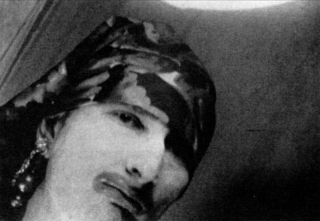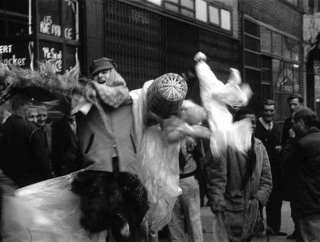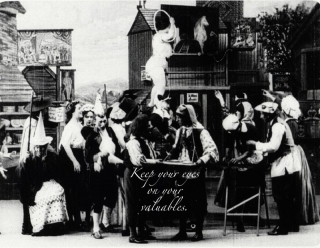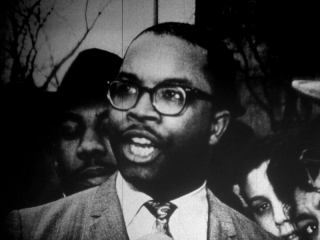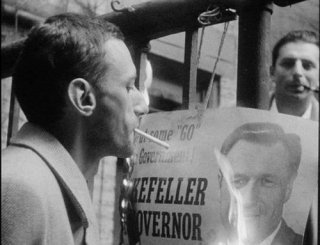Date: 31 March 2007 | Season: London Lesbian & Gay Film Festival 2007 | Tags: Ken Jacobs, London Lesbian & Gay Film Festival
FLAMING CREATURES & BLONDE COBRA
Saturday 31 March 2007, at 6.10pm
London Lesbian & Gay Film Festival at BFI Southbank
Jack Smith, Flaming Creatures, USA, 1963, 16mm, black and white, sound, 42 min
Ken Jacobs, Blonde Cobra, USA, 1959-63, 16mm, black and white & colour, sound, 33 min
Two gloriously primitive flicks which define and transcend the idea of “underground” film. Flaming Creatures, Smith’s impoverished, epic fantasy of Babylonian proportions, is a decadent celebration of the joy and torment of existence. This bleached-out orgiastic rite, all limp penises and shaking breasts, is populated by a blonde vampire, exotic Spanish dancers and androgynous bohemian poseurs. Blonde Cobra, as close to an authentic portrait of Smith that we have, is propelled by a delirious monologue (witness the scurrilous tale of Madame Nescience and Mother Superior) and was shot amongst the rubble of his apartment. The two films were premiered together in April 1963, and remain fresh, provocative and startlingly original over 40 years later. (Mark Webber)
PROGRAMME NOTES
FLAMING CREATURES & BLONDE COBRA
Saturday 31 March 2007, at 6.10pm
London Lesbian & Gay Film Festival at BFI Southbank
Jack Smith’s Flaming Creatures and Ken Jacobs’ Blonde Cobra (in which Smith stars) are two gloriously primitive flicks which define and transcend the idea of “underground” film. We can only begin to imagine the extraordinary reactions they might have caused in audiences of the early 1960s.
FLAMING CREATURES
Jack Smith, USA, 1963, 16mm, b/w, sound, 42 min
Flaming Creatures, an impoverished, epic fantasy of Babylonian proportions, supposedly caused riots at early screenings. Viewers were incensed not so much by what they saw, but for the lack of graphic pornography, which they expected from such an international cause célèbre. Smith’s polymorphous vision, all limp penises and shaking breasts, is something decidedly other: A bleached-out orgiastic rite populated by androgynous creatures (exotic Spanish dancers, bohemian poseurs and a blonde vampire), and a decadent celebration of the joy and torment of existence.
BLONDE COBRA
Ken Jacobs, USA, 1959-63, 16mm, b/w & colour, sound, 33 min
Blonde Cobra, made by Ken Jacobs from footage abandoned by Bob Fleischner, is as close to an authentic portrait of Smith that we have. Shot mostly amongst the rubble of his apartment and propelled by a delirious monologue (witness the scurrilous tale of Madame Nescience and Mother Superior), its freewheeling anti-form mixes image with black leader, recorded sound with live radio. Both films were premiered together in April 1963, and remain fresh, provocative and startlingly original over 40 years later. “Life swarms with innocent monsters.” (Charles Baudelaire)
Back to top
Date: 3 April 2007 | Season: London Lesbian & Gay Film Festival 2007 | Tags: Jack Smith, Ken Jacobs, London Lesbian & Gay Film Festival
TWO WRENCHING DEPARTURES
Tuesday 3 April 2007, at 8pm
London Roxy Bar and Screen
Secret Cinema presents a free screening of a major new work by Ken Jacobs.
In his amazing live performances, Ken Jacobs breathed new life into archival film footage, teasing frozen frames into impossible depth and perpetual motion with two 16mm analytic projectors. Now aged 74, the artist explores new ways of documenting and developing his innovative Nervous System techniques in the digital realm.
Two Wrenching Departures, featuring the legendary Jack Smith (both clownish and devilishly handsome circa 1957), extends five minutes of material into a ninety-minute opus of eight movements. In and out of junk heap costume, Smith cavorts through the streets of New York (much consternation from the normals) and performs an impossible, traffic island ballet.
His improvised actions are transformed into perceptual games as Jacobs’ interrogates his footage, using repetition and pulsating flicker to open up new dimensions and temporal twists: The infinite ecstasy of little things. In commemorating two dear departed friends, with whom he collaborated on Blonde Cobra and other works, he propels their image into everlasting motion. These mindbending visions are juxtaposed with the soundtrack of The Barbarian, a 1933 Arabian fantasy starring Ramon Navarro and Myrna Loy, and music by Carl Orff.
TWO WRENCHING DEPARTURES
Ken Jacobs, USA, 2006, video, b/w, sound, 90 min
“In October 1989, estranged friends Bob Fleischner and Jack Smith died within a week of each other. Ken Jacobs met Smith through Fleischner in 1955 at CUNY night school, where the three were studying camera techniques. This feature-length work, first performed in 1989 as a live Nervous System piece is a ‘luminous threnody’ (Mark McElhatten) made in response to the loss of Jacobs’ friends.”
Ken Jacobs (born 1933) is one of the key figures of post-war cinema, whose films include Little Stabs at Happiness (1958-60), Blonde Cobra (1959-63), Tom Tom the Piper’s Son (1969-71), The Doctor’s Dream (1978), Perfect Film (1986) and Disorient Express (1995). He has also presented live cine-theatre (2D and 3D shadow plays) and developed the Nervous System and Nervous Magic Lantern projection techniques. Since 1999, Jacobs has primarily used electronic media, both in preserving his live performances and creating new digital works in a variety of styles. His 7-hour epic Star Spangled To Death (1957-2004) is now available on DVD from Big Commotion Pictures.
Free admission. No reservation necessary, but arrive early to avoid disappointment.Please note that this screening is not suitable for those susceptible to photosensitive epilepsy due to the extensive use of flickering and throbbing light.
Related Events
Ken Jacobs’ 1963 film Blonde Cobra will screen with Jack Smith’s Flaming Creatures in the London Lesbian & Gay Film Festival on Saturday 31st March 2007 at 6.10pm.
Mary Jordan’s documentary Jack Smith and the Destruction of Atlantis also shows in the festival in the same day.
Back to top
Date: 19 September 2008 | Season: Ken Jacobs tank.tv | Tags: Ken Jacobs, tank.tv
RETURN TO THE SCENE OF THE CRIME
Friday 19 September 2008, at 7pm
London Tate Modern
In a contemporary riff on one of his landmark works, Ken Jacobs uses new technology to both interrogate and arouse a theatrical tableau, shot in 1905, based on Hogarth’s Southwark Fair. The antique film print is probed, exploded and reconstituted in the digital domain with radical ingenuity and infectious wit. This extraordinary new work teaches us how to see.
Ken Jacobs, Return to the Scene of the Crime, USA, 2008, video, colour, sound 92 min
“The heartwarming story of a boy who didn’t know it’s wrong to steal. Running off with the pig seemed like a good idea at the time.”
More than theft of a pig is taking place at Southwark Fair. Why does God, right there amongst the crowd, allow this cheery riffraff such liberties? I haven’t been so shocked since 1969, when I first examined this primitive 1905 movie with my camera (Tom, Tom, the Piper’s Son, added in 2007 to the Library of Congress National Film Registry). A better print of the original film, and the power of the computer, allows for deeper and more detailed inspection. Forensic cinema at its most obsessive, the dead rise … and prove quite entertaining.
Curated by Mark Webber for tank.tv and Tate Modern. An online exhibition at www.tank.tv from 1 October to 30 November 2008 includes a selection of 20 complete or excerpted works by Ken Jacobs, dating from 1956 to the present.
Date: 1 October 2008 | Season: Ken Jacobs tank.tv | Tags: Ken Jacobs, tank.tv
KEN JACOBS
1 October—30 November 2008
www.tank.tv
Ken Jacobs (b.1933) has been active as a filmmaker, performer and teacher for the past five decades. Rigorous and dedicated, his work is characterised by a keen eye for formal composition and a fierce political consciousness. The online exhibition at tank.tv presents a portfolio of 20 works covering 50 years of Ken Jacobs’ artistic production from 1957 to the present day.
The Whirled (1956-63), Star Spangled To Death (1957-59/2004), Little Stabs At Happiness (1958-63, Blonde Cobra (1959-63), The Sky Socialist (1964-65), Tom, Tom, The Piper’s Son (1969-71), The Doctor’s Dream (1978), Perfect Film (1985), Flo Rounds A Corner (1999), New York Street Trolleys 1900 (1999), Circling Zero: We See Absence (2002), Krypton Is Doomed (2005), Let There Be Whistleblowers (2005), Ontic Antics Starring Laurel And Hardy; Bye, Molly! (2005), The Surging Sea Of Humanity (2006), Capitalism: Child Labor (2006), New York Ghetto Fishmarket 1903 (2006), Two Wrenching Departures (2006), Razzle Dazzle: The Lost World (2006), Return To The Scene Of The Crime (2008).
As a central figure of the generation that defined independent filmmaking during the post-War era, Jacobs contributed to the liberation of cinema from technical and ideological conventions. Beginning in the 1950s, he developed an ‘urban guerrilla cinema’ out of poverty and desperation, shooting improvised routines on city streets. The early works Star Spangled to Death, Little Stabs at Happiness and Blonde Cobra feature a nascent Jack Smith, years before the renegade artist produced his own films.
Having lived in New York all his life, the changing character of the city has been a strong presence throughout Jacobs’ work, from his manipulation of vintage street scenes in New York Ghetto Fishmarket 1903, through to the diaristic video Circling Zero: We See Absence, which observes the aftermath of the attack on the World Trade Center, a few blocks away from Jacobs’ home. The Sky Socialist was shot in a deserted neighbourhood (long since decommissioned) below the Brooklyn Bridge in the 1960s, and Perfect Film uses raw television news reports on the assassination of Malcolm X.
Found or archival footage is a source for much of Jacobs’ work. In Star Spangled to Death, entire appropriated films contribute to an accumulative denunciation of American politics, religion, war and racism, whereas an analytical approach to reclaiming cinema’s past was originated in Tom, Tom the Pipers’ Son by re-filming selected details of a theatrical production dating from 1905. This same footage has lately been digitally excavated in Return to the Scene of the Crime.
The technique of unlocking aspects of film material that would otherwise pass unnoticed is the essence of the live Nervous System pieces that Jacobs has performed with two adapted projectors since the mid-1970s. Repetition and pulsing flicker teases frozen images into impossible depth and perpetual motion (demonstrated in New York Street Trolleys 1900), a process further developed by the Eternalism system of editing used in many recent videos. The previously ephemeral live performances Ontic Antics Starring Laurel And Hardy; By Molly! and Two Wrenching Departures are amongst the works that take on new life in their digital form.
A contemporary of Stan Brakhage, Bruce Conner and Jonas Mekas, Ken Jacobs is one of the true innovators of the moving image, who continues his radical practice in the present. Though his images frequently depict bygone eras, the works are resolutely contemporary, displaying a vitality and ingenuity that is rarely matched.
ASK KEN!
For the duration of the online show, tank.tv offered a unique opportunity for discussion with Ken Jacobs in an extended Q+A session. Questions sent by email were answered by the artist and a regularly updated transcript of the dialogue was posted online at www.tank.tv.
Curated by Mark Webber.
Date: 2 November 2008 | Season: Ken Jacobs tank.tv | Tags: Ken Jacobs, tank.tv
STAR SPANGLED TO DEATH
Sunday 2 November 2008, 2pm-10pm
London Chisenhale Gallery
A free screening of Star Spangled to Death, Ken Jacobs’ episodic indictment of American politics, religion, war, racism and stupidity, timed to coincide with the US election and the end of the Bush regime. Starring Richard Nixon, Nelson Rockefeller, Mickey Mouse, Al Jolson and a cast of thousands.
Ken Jacobs, Star Spangled to Death,1957-59/2004, USA, 400 min
Jacobs’ extraordinary epic combines whole found films, documentaries, newsreels, musicals and cartoons with improvised performances by the legendary Jack Smith and Jerry Sims. Together they picture a dangerously sold-out America where racial and religious prejudice, the monopolisation of wealth and an addiction to war are opposed by Beat generation irreverence.
Star Spangled to Death will be shown with several intermissions. Refreshments available, or bring a packed lunch and a cushion!
Presented by Whitechapel at the Chisenhale, in collaboration with Mark Webber, tank.tv and Firefly. An online exhibition at www.tank.tv from 1 October to 30 November 2008 includes a selection of 20 complete or excerpted works by Ken Jacobs, dating from 1956 to the present.
PROGRAMME NOTES
STAR SPANGLED TO DEATH
Sunday 2 November 2008, 2pm-10pm
London Chisenhale Gallery
STAR SPANGLED TO DEATH
Ken Jacobs, USA, 1957-59/2004, video, b/w & colour, sound, 400 min
Star Spangled To Death is an epic film costing hundreds of dollars! An antic collage combining found-films with my own more-or-less staged filming (I once said directing Jack and Jerry was like directing the wind). It is a social-critique picturing a stolen and dangerously sold-out America, allowing examples of popular culture to self-indict. Race and religion and monopolisation of wealth and the purposeful dumbing down of citizens and addiction to war become props for clowning. In whimsy we trusted. A handful of artists costumed and performing unconvincingly appeal to audience imagination and understanding to complete the picture. Jack Smith’s pre-Flaming Creatures performance is a cine-visitation of the divine (the movie has raggedly cosmic pretensions). His character, The Spirit Not Of Life But Of Living, celebrates Suffering, personified by poor rattled fierce Jerry Sims, as an inextricable essence of living.
I was 24 when I began the film, Jack 25. Jerry in his mid-thirties seemed middle-aged to us. Jack later said, I think appreciatively, I taught him to hate America. We met 1954 and got to hanging around, broke most of the time, walking the streets “shadow starved” (Jack’s expression) for movies a mind could fix on. Max Ophuls’ Sins Of Lola Montez, even in its producer-reassembled state, stood out in its love of the art, in showing what a camera could still do. Hollywood with some few exceptions had gone numb, frantic and numb in this time of fascist ascendance and cultural impoverishment. The enemy had been switched from Right to Left at the end of World War II and the owners had returned with a vengeance. Their message was simple: “Shut up and do what you’re told.” War had done the trick of loosening industry from its Depression fix and war would now be America’s raison d’être. War would serve to rid the country of excess wealth, lest more equitable distribution shake its class structure. In light of how much bullshit it takes to win a war, consider the bullshit it takes to sell ongoing war-to-war-to-war; we were inundated. Only the Abstract-Expressionist painters had been left to proclaim the old radical hopes (because the liberties they took were abstract). The Sixties were nowhere in sight.
Then one day on the set (the rear courtyard of the W. 75 St. brownstone where I was janitor) Jack pushed a copy of ‘On The Road’ into my hands, saying, “It’s about us.” I’d been reading Paul Bowles and H.P. Lovecraft and a smuggled in copy of ‘Lolita’ and the drop in writing level was too steep. “You’ll be able to stay with it on your sixth attempt”, Jack said, which proved to be true. It caught some things right, quirky ephemerals that hadn’t registered as events. Of course it helped stir a social revolution (disowned by Kerouac) and maybe Star Spangled To Death would’ve participated in that great humanist eruption if I had completed it and got it out in its proper time. Over six hours then, there was no way I could pay final sound-joining and printing lab costs. I screened camera originals a few times to records and spoken commentary but money didn’t happen and, pissed, in 1963 I put it aside to continue with affordable works (like near cost-free shadowplay). Its moment, I felt, had passed. Its invention, the very look of it, its texture was to a degree no longer unique. My pride was wounded. People were treating me as if I was normal. I got a measure of Jack’s fame when I heard a girl address her dog as Flaming Creature, but he chose – at a time when patrons were available to him – not to help. Like maybe his movie might be seen as coming from somewhere. I let it go and had another life, better I’m sure than the one that would’ve resulted from the release then of Star Spangled To Death.
I recall thinking when Kennedy took office there was less urgency to get it out. He looked like he had a sex life, had little kids that he surely wanted to raise above-ground, and indeed he did interfere with the Eisenhower plan to return Cuba to The Mob, costing him his life.
Video makes its present release possible. Yeah, yeah, it ain’t film, and I’d already begun my quest with it into the actuality of film rather than film as transparency. Rising from my own abstract-expressionist mindset. Let me be. I so appreciate what video permits (although the work, with one sinful exception, the reprise of ‘Are You Havin’ Any Fun?’, does not take off into electron free-play but stays respectful of film limits), and I appreciate the possibility of cheap DVD distribution. And if anyone has the passion and money and patience the video can guide final assembly of the film. At age 70 I have to attend to other cine-demands, like leaving something lasting of what Flo and I did in live performance with The Nervous System and Nervous Magic Lantern.
“Something lasting”? Habit of thought. I wonder if our masters (the hallowed image of The White House insists, to the subconscious, that The Old Plantation prevails) figure, in rationalising a way to live with their crimes, that “natural death” is often no less painful than an accelerated conclusion, so what the hell, the little fuckers will replenish their numbers soon enough. From where they are we all look alike, excepting those of us that stand up. I don’t feel hopeful when Bush lies are exposed, implausible to begin with; followers elect to believe, and hold on to beliefs doggedly. Followers expect leaders to lie and believing an obvious lie is how they demonstrate their faith. Lying mostly offends professors and not all of them by a long shot. No, I think we’re due to be interrupted, that history is about to come down through the roof on us this time. Sorry, truly, but I believe my film-title. Perhaps that it arose to mind almost a half-century ago and so many of us are still here, in sight of scientific breakthroughs galore, is reason for confidence in ongoing life. We certainly can resist the bastards! They are taking our lives, what more can we lose? Jack fumbled the making of his last film but how meaningful a title is No President.
Here, explaining, you get gravity. The movie achieves levity.
Is this video the real thing? In the winter of 1959 editing facilities were two nails in a wall holding two film reels and an enlarging glass and in 2003 a G4 with Final Cut Pro. Better to figure the entirety as another entry in my found-film oeuvre. I did drop some found-films from the original collage, including all biographic elements (like my maybe-father’s third-wedding home-movies), replacing with items more on track with central concerns of the work. Stuff gathered over the years with SSTD in mind, only some that could be squeezed into its ultimate realisation. The Follies entered sometime in the Sixties, the Micheaux entered my life with a bang in 1968 (Ten Minutes To Live being up there with the greatest; the DVD of SSTD should by rights be a double-feature with Ten Minutes To Live seeing as the titles go so well together) but only infiltrated SSTD during this latest editing. Ronald Reagan and the twerp presiding now, how ignore them? Perhaps with precisely the same pitch of outrage as my younger self I would not have made any concessions to audience capacity, only added things. There’s friends, I know, that will be glum over what they will perceive as signs of an orderly mind. My head, inside, isn’t all that different from what it was, I didn’t become someone else, but I did get the work together and in a profound way that’s the problem. It was supposed to lie in a jumbled heap, errant energies going nowhere, the talented viewer inferring form. A Frankenstein that fizzled but twitching and still dangerous to approach. Thoroughly star spangled but still kicking. —Ken Jacobs
Back to top
